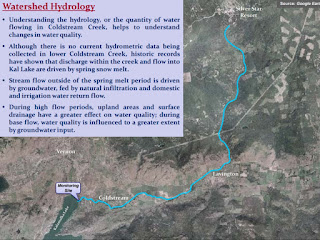1) The Hydrology of the Creek
Coldstream Creek has its headwaters near Silver Star Mountain Resort and its mouth near Kalamalka Beach. It has a mainstem length of about 30 kilometres and “a watershed area of approximately 206 km (squared). Flowing south from Silver Star Provincial Park, Coldstream Creek discharges into Kalamalka Lake within the District of Coldstream. Coldstream Creek is characterised by steep headwaters, flowing onto a broad valley floor near the community of Lavington.”
Coldstream Creek and ground water provide 80% of the inflow to Kalamalka Lake which in turn provides drinking water for much of the Greater Vernon area. The creek’s entrance to Kalamalka Lake can be found in the Kalavista subdivision near Kirkland Park and boat launch.
2) The Aquatic Life
As one report sums it up:
“Coldstream Creek contains both spawning and rearing habitat for rainbow trout and is one of the most prolific kokanee salmon spawning streams in the Okanagan (Aqua Resource Management Inc. 2001). The section of creek below the dam and settling pond at Coldstream Ranch serves as an extremely important area for spawning fish, especially for kokanee salmon migrating upstream from Kalamalka Lake (MOE 1982).”
 |
| Kokanee Salmon - By Hemming1952 - Own work, CC BY-SA 4.0, https://commons.wikimedia.org/w/index.php?curid=75505541 |
Anne Pearson writes: “…89 year old Leslie Macdonell recalls that every September many Indians would come from the reserve at the head of Okanagan Lake to the mouth of the Coldstream Creek, to net Kokanee heading up stream. ‘They smoked them on the banks of the creek’”. ((An Early History of Coldstream & Lavington p.4)
3) The Irrigation
There is a long history of using Coldstream Creek for irrigation purposes in the Valley.
“Around the year 1900, streamflows within the upper watershed were diverted to supplement irrigation within the Coldstream / Lavington area. This diversion of the upper headwaters from east to west flows along the valley bottom for a few kilometers before joining with the existing creek bed at the junction of Brewer and Craster Creeks (Aqua Resource Management Inc. 2000).”
4) The First Nations
As was already mentioned the Okanagan First Nations people caught salmon from Coldstream Creek for many years. In 1874 John Jane surveyed the lands around Vernon and Coldstream and we learn that he came across an indigenous man who was most likely the son of the famous Chief Kalamalka.
 |
| Early photo of Cohastimene (or Goestamana) |
Again Pearson records: “While he was surveying the Coldstream, Jane recorded in his field notes that “the land at the mouth of Coldstream Creek is occupied by an old Indian named Francois (*probably Cohastimene, son of Kalamalka), who has about 40 to 60 acres fenced and under cultivation. He has a paper dated 1861 signed by Judge Cox warning people not to trespass on this ‘Indian Reservation’.”” (An Early History of Coldstream & Lavington p.3-4)
5) The European Settlers
In 1863, Charles Houghton (along with the Forbes and Charles Vernon) came over from Ireland via New York and across the Isthmus of Panama. The town just north of Coldstream Creek would come to be named after Forbes Vernon. However, it was Houghton who named what is now the district of Coldstream. Upon exploring the area, Houghton wrote:
“A good sized stream of pure water flows right down the middle of the valley and emptys into the Hd. Of Long Lake.” Margaret Ormsby records: “The stream he named Coldstream Creek. And on its banks he intended to locate his military grant, which he would call “Coldstream” (Coldstream Nulli Secundus p.2).
 |
| Charles Frederick Houghton |
There are two theories as to why Charles Houghton named the creek (and this the surrounding area) Coldstream. One is simply that it was a “cold stream”. The other suggests that, as a former military man, he may have been familiar with the Coldstream Guards – “the oldest regiment in the British Army in continuous active service, originating in Coldstream, Scotland, in 1650…”. Either way, the District of Coldstream has adopted the motto of the military regiment – “Nulli Secundus” meaning “Second to None”.
Sources & Further Reading:
(https://www.obwb.ca/newsite/wp-content/uploads/OBWB_EFN_May2016_appendixF.pdf)
(https://www.obwb.ca/wcqi_project/kalamalka-lake-and-coldstream-creek-protection-and-response/)



No comments:
Post a Comment